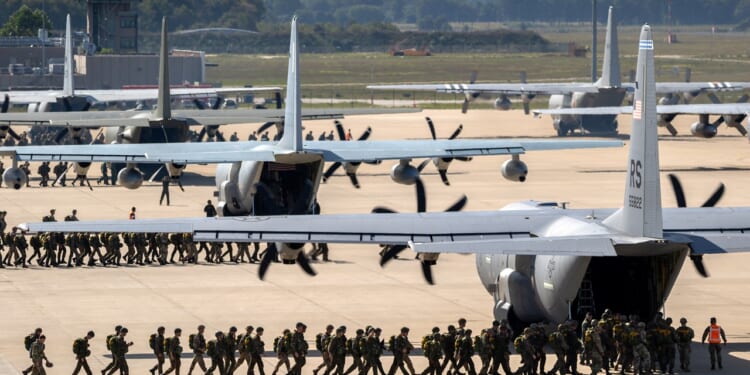On its face, the removal of 1,000 US troops from a temporary deployment in Romania is not militarily significant—but it could lead to further withdrawals from Europe.
The gnawing and weeping and gnashing of teeth in Washington, DC, over the recent US troop drawdown in NATO’s eastern flank has been quite an ordeal to witness from afar. One would think that President Donald Trump had finally fulfilled the wishes of some of his biggest supporters and abandoned NATO.
But that isn’t quite what happened. Indeed, the decision not to replace one of its rotational brigades, the United States Army’s Second Infantry Brigade Combat Team from the 101st Airborne Division that had been operating out of Mihail Kogǎlniceanu Air Base in Romania is not at all that controversial.
After all, the roughly 1,000 US troops that had been deployed were only ever meant to be deployed there temporarily. But it just goes to show how the NATO bureaucracy really works. What was always intended by the Pentagon to be a temporary deployment to NATO’s eastern periphery was actually meant to be a backdoor toward a larger and longer commitment by the United States on behalf of the NATO bureaucracy.
And now that Trump has gummed up those carefully laid designs, the Europeans (and their globalist allies in DC) are screaming like stuck pigs.
The Strategy Behind Trump’s Move
Romania is an interesting choice, too. It has become the epicenter of NATO’s grand plans in the wake of the Ukraine War. While the Pentagon has admitted this move of the 1,000 US Army light infantry elements out of Romania is part of a larger repositioning of forces to the Indo-Pacific, the unit in question was always going to rotate out. But the real reason that so many Atlanticists in Europe and Washington are raging over the move is because they fear what this is a prelude to.
Even before the rotation occurred, there was growing concern among the European NATO members that the Trump administration, despite its continuation of the Biden-era arms shipments to Ukraine, was getting cold feet about maintaining America’s historic commitment to NATO.
Further, Politico leaked a document believed to have been penned by the Euroskeptical Undersecretary of Defense for Policy Elbridge Colby that effectively outlined how the US was going to deprioritize the theaters it has been involved in—mainly Europe and the Middle East—and instead would prioritize USSOUTHCOM and USNORTHCOM for a Western Hemispheric Defense strategy.
A related document, the Unified Command Plan (UCP) made mention of the need to shift key resources out of the European Command (EUCOM) and Central Command (CENTCOM) areas of responsibility and into the Western Hemisphere.
Interestingly, while it had always been assumed that any rebalancing of US forces out of Europe and/or the Mideast would be to counter China’s rise in the Indo-Pacific, one must not write off the possibility that such a rotation to the Indo-Pacific is merely a pitstop for US forces that will ultimately be permanently redeployed to the Western Hemisphere.
Colby’s document remains on Secretary of Defense Pete Hegseth’s desk.
What Will Hegseth Do Next?
It is likely that even Hegseth is worried about the optics of the document and is trying to stage manage the movement of American forces to regions that he and the president prefer those forces to be positioned in. Although, the fear and loathing exhibited by the globalist set in Washington and Brussels is an indicator that they know there’s more going on (without actually knowing it).
Between Trump’s insistence with acquiring the Panama Canal Zone, empowering Argentina, threatening Venezuela, attacking drug cartels, and absorbing Greenland into the United States, it is clear that his vision for American grand strategy is ultimately Western Hemispheric Defense.
That’s why the powers that be in Washington are having conniptions. It’s why NATO is so scared right now. Removing a light infantry unit that was technically never going to be permanently stationed in Romania is one thing. But what that move heralds is why so many are angry.
About the Author: Brandon J. Weichert
Brandon J. Weichert is a senior national security editor at The National Interest. Recently, Weichert became the host of The National Security Hour on America Outloud News and iHeartRadio, where he discusses national security policy every Wednesday at 8pm Eastern. He is also a contributor at Popular Mechanics and has consulted regularly with various government institutions and private organizations on geopolitical issues. Weichert’s writings have appeared in multiple publications, including The Washington Times, National Review, The American Spectator, MSN, and the Asia Times. His books include Winning Space: How America Remains a Superpower, Biohacked: China’s Race to Control Life, and The Shadow War: Iran’s Quest for Supremacy. His newest book, A Disaster of Our Own Making: How the West Lost Ukraine is available for purchase wherever books are sold. He can be followed via Twitter @WeTheBrandon.
Image: Shutterstock / VanderWolf Images.


















